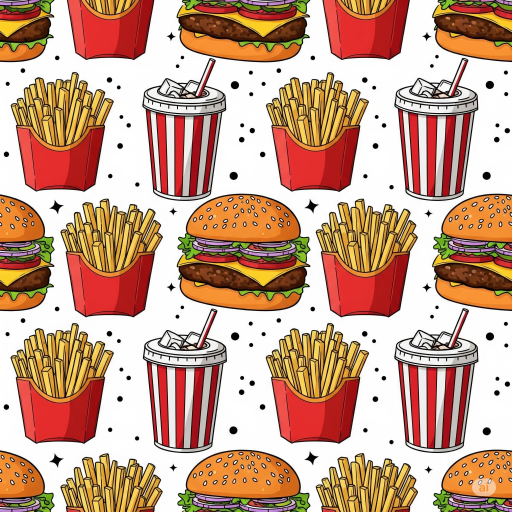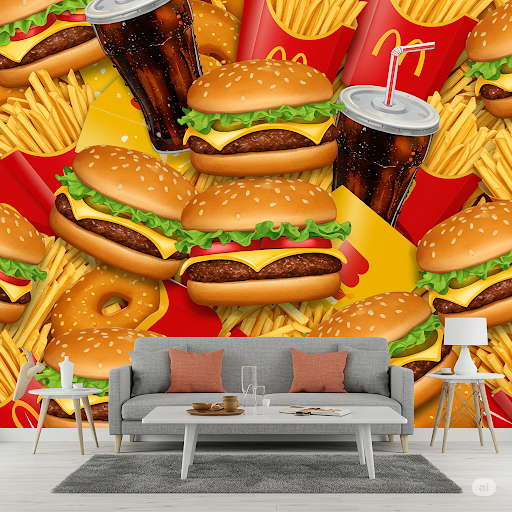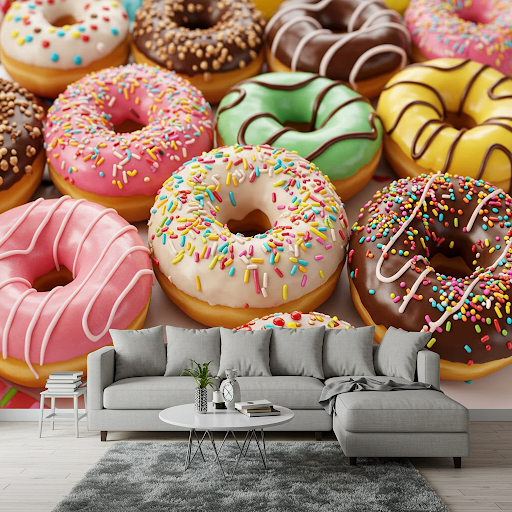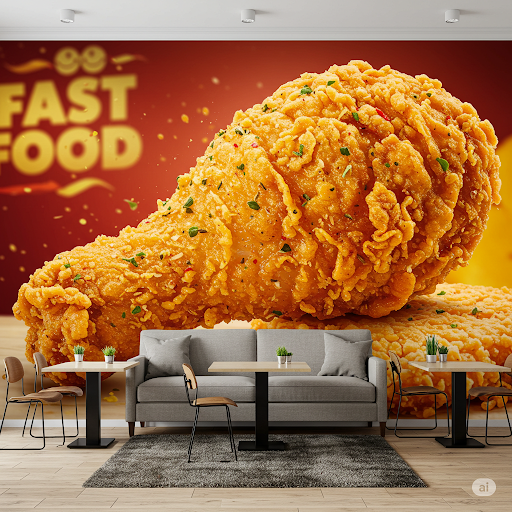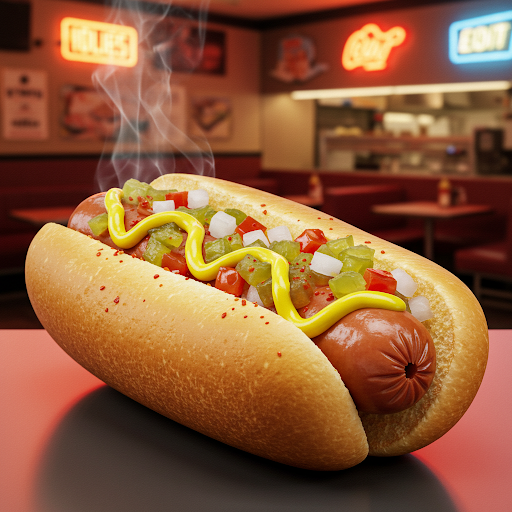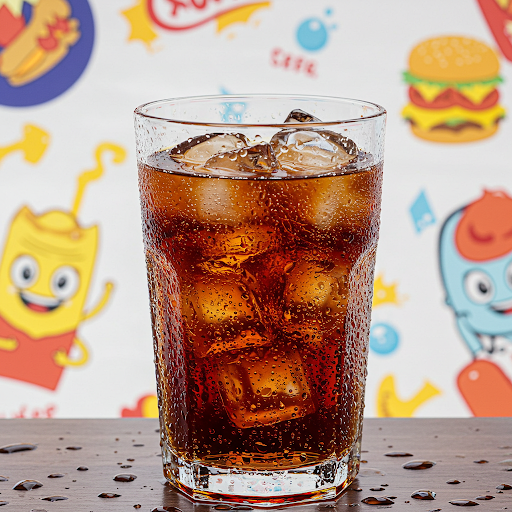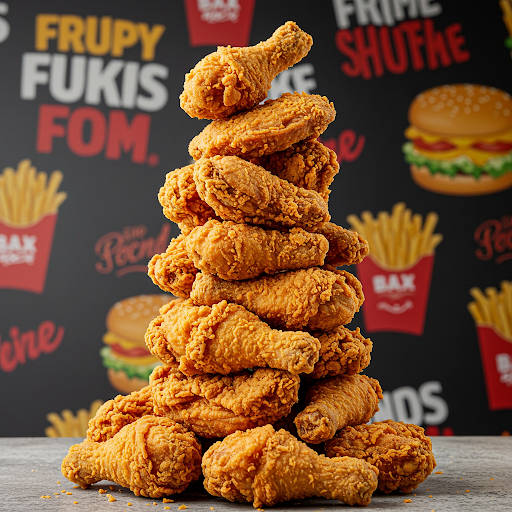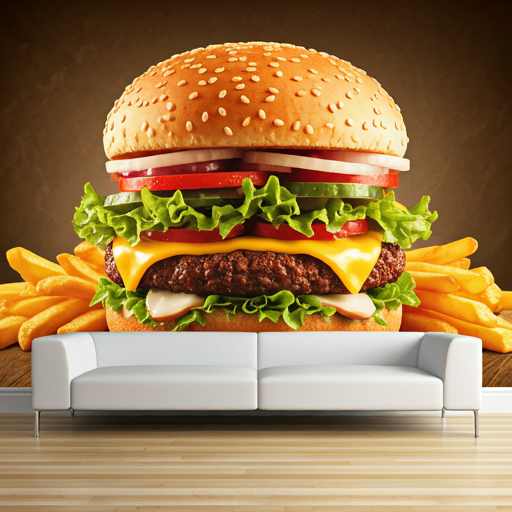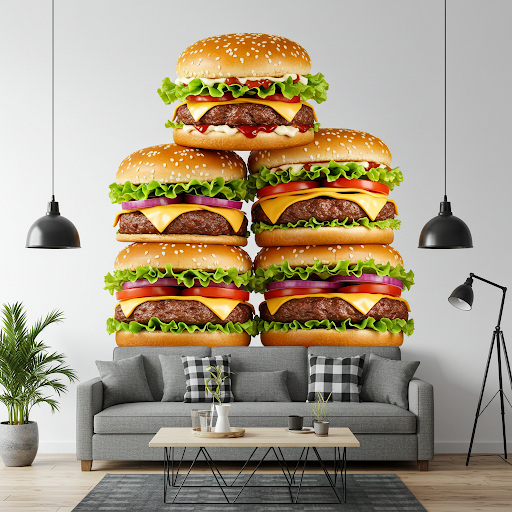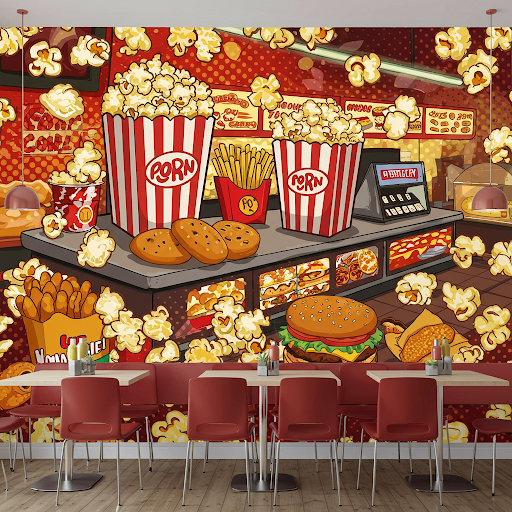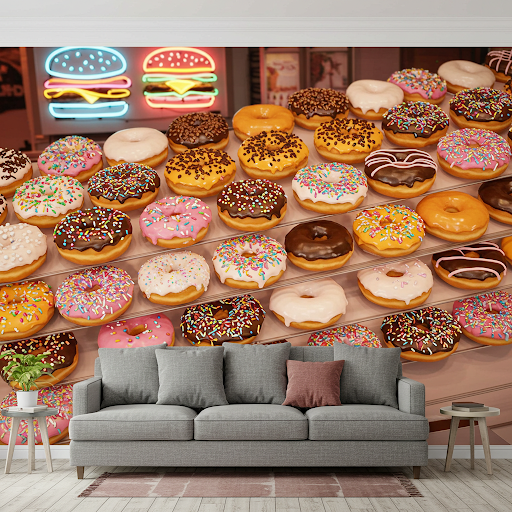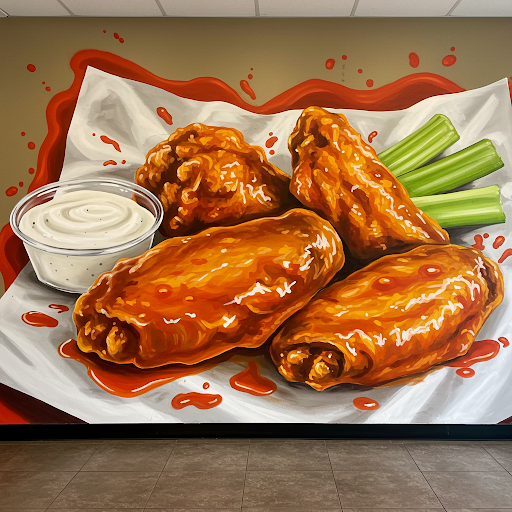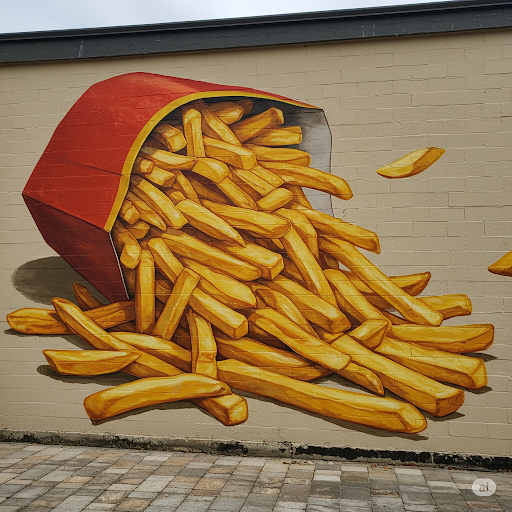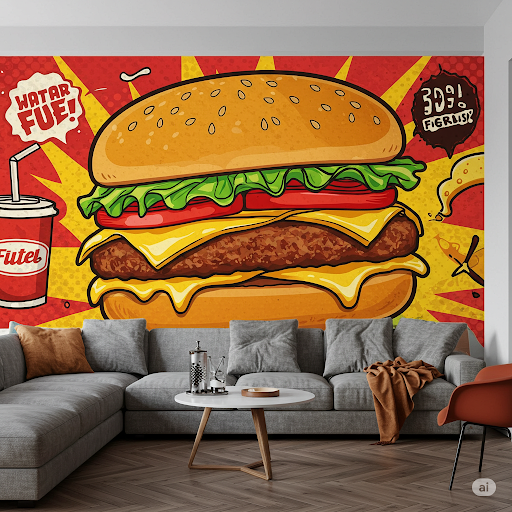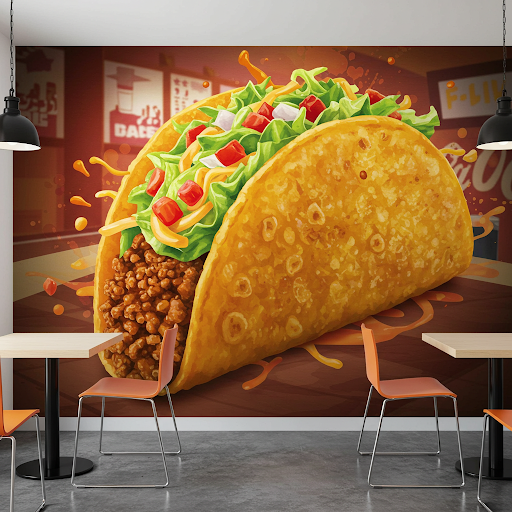Description
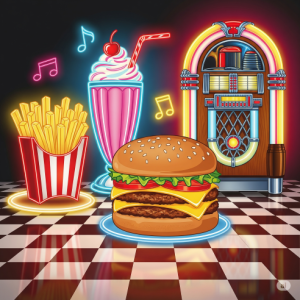
Custom-made fast food wallpaper designs are a great way to create a unique and memorable atmosphere for a restaurant, cafe, or even a home kitchen or game room. Here’s a guide to help you come up with creative and effective designs:
Before you start sketching, consider the overall feel you want to achieve and who you’re designing for.
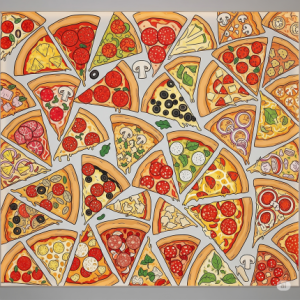
Modern & Sleek Fast Food Wallpaper Designs

To craft a modern and sleek fast food wallpaper design, you’ll want to focus on a few key elements. Ditch the busy, colorful chaos typically associated with fast food and opt for a clean, minimalist approach.
Start with simplified food silhouettes. Instead of detailed illustrations, use bold, geometric shapes to represent a burger, a soda cup, or a cartoon of fries. Think of clean lines and negative space.
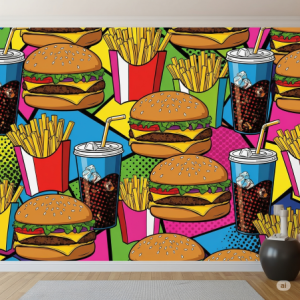
Limit your color palette to just a few shades—perhaps a monochromatic scheme like black and white, or a muted pairing with a single pop of a vibrant color like a deep red or mustard yellow. This creates a sophisticated, uncluttered look. The goal is to convey the idea of food without being too literal, making the design feel more like a piece of contemporary art. This style works best for spaces aiming for a refined, urban feel, appealing to a demographic that values style and simplicity over traditional, loud branding.
Playful & Fun Fast Food Wallpaper Designs
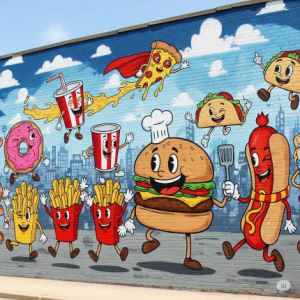
To create playful and fun fast food wallpaper designs, embrace a vibrant, high-energy style that captures the joy of eating. Start with a bright and bold color palette, like ketchup red, mustard yellow, and pickle green, to instantly grab attention.

Think about using cartoonish or doodle-style illustrations of classic fast food items. Give a cheeseburger a big, goofy grin, have a fry “wave” to the viewer, or show a milkshake with swirly whipped cream and a cherry on top. You can even create an entire scene, with a happy crew of anthropomorphic food items celebrating together.
This style is perfect for spaces that cater to a younger audience, such as a family-friendly restaurant or a home game room. The whimsical and lighthearted visuals encourage a fun, casual atmosphere, making the space feel approachable and full of personality.
Retro & Nostalgic Fast Food Wallpaper Designs
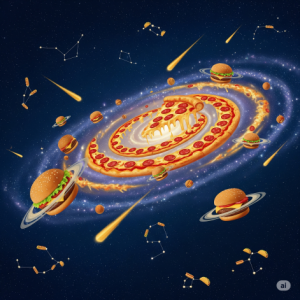
To create a retro and nostalgic feel for your fast food wallpaper, look to the past for inspiration. A great starting point is vintage fast food advertisements from the mid-20th century. Think about the classic, diner-style aesthetic with its bright colors and playful fonts.
A pop-art style is an excellent choice for this theme. Use bold, thick outlines and vibrant, saturated colors to illustrate iconic items like burgers, milkshakes, and French fries. The high-contrast look immediately grabs attention and feels both energetic and timeless.
Another powerful option is a neon sign aesthetic. You can design illustrations that mimic the glow and style of classic neon lights, perhaps with a faux-flickering effect. This style brings a cool, late-night vibe that perfectly captures the feeling of a roadside diner. Both of these approaches tap into a sense of nostalgia that appeals to older generations while remaining fun and visually appealing to all ages.
Industrial/Urban
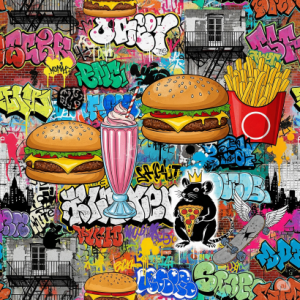 For an industrial or urban fast food wallpaper design, start by merging classic fast food visuals with raw, city-inspired textures. Think of a background that mimics an exposed brick wall, weathered concrete, or even a metal corrugated sheet. Additionally, you can layer dynamic fast food imagery.
For an industrial or urban fast food wallpaper design, start by merging classic fast food visuals with raw, city-inspired textures. Think of a background that mimics an exposed brick wall, weathered concrete, or even a metal corrugated sheet. Additionally, you can layer dynamic fast food imagery.
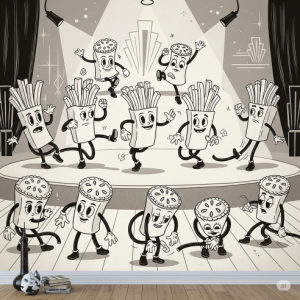
To achieve this, use graffiti-style art that features stylized burgers, dripping soda cups, or scattered French fries. The design should feel spontaneous and energetic, as if an artist tagged the wall. Incorporate bold, contrasting colors like vibrant reds, yellows, and hot pinks to make the food pop against the neutral, gritty backdrop. You can also integrate typography with rough, stenciled fonts to include menu items or a catchy slogan. The goal is to create a rebellious and modern aesthetic that captures the raw energy of an urban environment, perfect for a contemporary restaurant or a teen’s room.
2. Choose Your Fast Food Wallpaper Designs Style and Imagery
Once you have a vibe, select a visual style that brings it to life.
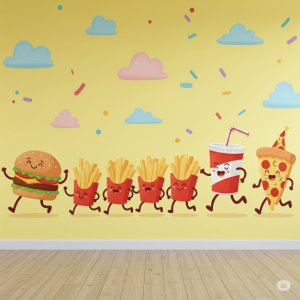
Illustrative/Cartoon
Creating an illustrative or cartoon fast food wallpaper is all about fun, whimsy, and vibrant personality. This style allows you to go beyond realistic representations and create a world where food comes to life. Start by developing charming, personified characters for each item—a winking burger, a pair of French fries dancing with a smile, or a mischievous, straw-sucking milkshake.
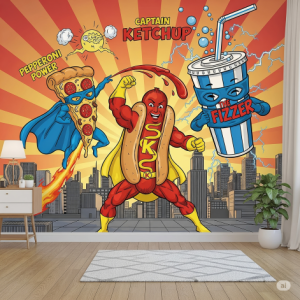
The design can feature these characters in a repeating, seamless pattern that feels dynamic and busy, or you can create a single, larger mural with a narrative. For example, a mural could show a “fast food party” with all the characters interacting in a playful scene. The use of bold, hand-drawn outlines and a bright color palette—think cherry red, sunny yellow, and bubblegum pink—is key to achieving that classic cartoon feel. This style works perfectly for spaces catering to families or a young, playful audience, creating a lighthearted and memorable atmosphere.
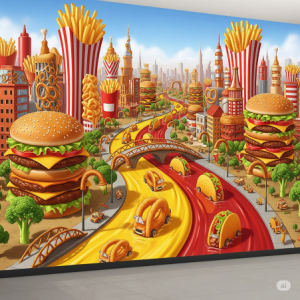
Photography
If you want to make your fast food wallpaper designs mouthwatering, consider using high-quality photography. This approach is all about realism and detail, making the food look as tempting as possible. Think of a mural that features an extreme close-up of a juicy, flame-broiled patty, with the grill marks clearly visible and a slice of cheese just beginning to melt over the edge.
The key is to focus on enticing textures and colors. You could highlight the golden-brown crispiness of a fried chicken wing or the glistening sheen of a soda in a frosty glass. The larger-than-life scale of a mural allows you to celebrate these small details, making the food the undeniable star. This style is incredibly effective for creating a sense of deliciousness and can make a strong statement in a restaurant, a home dining area, or even a bar where you serve food. The goal is to make people’s stomachs rumble just by looking at the walls.
Typography
For a typography-focused fast food wallpaper design, the goal is to make words the star of the show. This modern and casual approach creates a powerful statement without relying on traditional imagery. Think of a wall completely covered in a bold, repeating pattern of food-related words or the restaurant’s slogan.
You can mix different font styles—a playful, handwritten script for “Delicious” and a thick, blocky font for “BURGERS.” Varying the size and weight of the text creates a dynamic, layered effect. For instance, a large, dominant “EAT” could be surrounded by smaller, scattered words like “Fries,” “Shakes,” and “Hot Dogs.” This design is perfect for capturing a youthful, energetic vibe. Use a vibrant, limited color palette to keep the look clean and impactful, making the typography not just readable, but a central piece of the decor.
Abstract & Pattern-Based Fast Food Wallpaper Designs
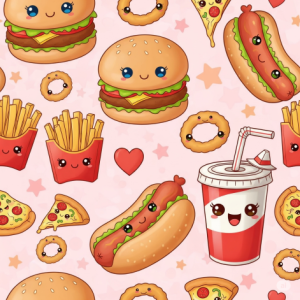
If you’re aiming for a modern and playful feel, an abstract and pattern-based wallpaper design is an excellent choice. This style moves beyond literal depictions and uses shapes and colors to evoke the idea of fast food. Think about using geometric shapes inspired by your menu items. For example, a simple circle can represent a burger patty or a bun, while a series of long, thin rectangles can mimic French fries. You could also use a group of triangular shapes to suggest a slice of pizza.
To add dynamism, integrate swirls and splatters of sauces—ketchup, mustard, or even cheese—in a way that feels energetic and a little messy. This adds a sense of fun and motion to the design. The repeating pattern creates a rhythmic and clean look that can be both subtle and eye-catching, making it a sophisticated option for a restaurant or even a home kitchen.
“Deconstructed” or Ingredient-Focused
Designing a “deconstructed” fast food mural is a sophisticated way to highlight the quality and freshness of ingredients. Instead of showing the final, assembled product, you focus on the individual components, giving them a chance to shine as works of art.
To start, you can isolate and magnify key ingredients like a juicy beef patty, a crisp lettuce leaf, a plump tomato slice, or the swirl of a milkshake. These elements can be arranged in a dynamic, scattered pattern, giving a sense of motion as if the dish is being built in mid-air. Use clean lines and a simple color palette to maintain a modern, minimalist aesthetic. The layout itself can be abstract, with ingredients “floating” across the wall. The design can be as simple as showing a single, perfect tomato slice or as complex as a mural that presents every layer of a signature sandwich. This approach elevates fast food from a quick meal to a culinary experience, emphasizing the freshness of each component.
3. Incorporate Key Fast Food Design Elements
These elements are crucial for making your mural work as a custom piece.
Branding
Using a custom fast food mural is a powerful way to reinforce your brand identity. Instead of just a wall covering, it becomes a storytelling tool. You can integrate the restaurant’s logo subtly into a larger scene or make it a central, eye-catching element. Beyond the logo, think about incorporating your brand’s specific color palette to create a cohesive and recognizable atmosphere. For example, if your brand’s story is about fresh, locally-sourced ingredients, the mural can depict the journey of a farm-fresh tomato or a cow grazing in a field, connecting your food to its origin. This visual narrative not only looks great but also builds customer loyalty by engagingly communicating your values.
Color Psychology
Colors can significantly influence a diner’s mood and appetite. Fast-food chains often use a combination of red and yellow because these colors are known to stimulate hunger and create a sense of urgency. Red, a high-energy color, can increase heart rate and metabolism, making people eat faster and encouraging a quicker turnover. Yellow is associated with happiness, warmth, and cheerfulness, which makes diners feel welcomed and relaxed, yet still ready to order. In contrast, colors like blue or purple are rarely seen in fast-food settings because they can act as appetite suppressants. Meanwhile, green is increasingly used by brands focused on healthy eating, as it evokes feelings of freshness, nature, and well-being.
Red, Yellow, and Orange
The dominance of red, yellow, and orange in fast food branding is no accident—it’s a deliberate psychological strategy. Red is a powerful color that captures attention, increases heart rate, and stimulates the appetite. It creates a sense of urgency and energy, encouraging a fast-paced dining experience. Yellow is associated with happiness, warmth, and friendliness. When paired with red, it creates a welcoming and cheerful atmosphere that makes diners feel good about their meal. Orange, a blend of red and yellow, embodies enthusiasm and creativity while also stimulating the senses. This combination not only makes food look more appealing but also encourages impulse purchases, perfectly aligning with the fast-turnover model of the industry.
Green
Green is a popular choice for “healthier” fast food concepts because it psychologically connects food with freshness and nature. It evokes feelings of health, vitality, and well-being. This color is often associated with organic or plant-based ingredients, making it an effective way to communicate a wholesome and natural brand identity to customers seeking healthier options.
Scale and Composition
Since it’s a custom mural, you have considerable flexibility. You can create a large, single-image focal point or a repeating pattern that covers an entire wall. Consider how the design will integrate with the room’s furniture, lighting, and other decorative elements.
Interactive Elements
To encourage engagement, consider designing a mural with elements like a chalkboard section for daily specials or a spot where customers can take an “Instagram-worthy” photo.
4. Technical Considerations for a Custom Mural
High-Resolution Artwork
Custom murals require a high-resolution image to ensure the final product doesn’t appear pixelated or blurry, especially when displayed on a large scale.
Material
The type of material the mural is printed on matters. Consider durable options like silk fabric, which is easily cleaned and resistant to spills and scuffs.
Measurements
Provide precise wall dimensions to us to ensure a perfect, custom fit with no waste or awkward pattern matching. It’s often recommended to add a small margin (a few centimeters) to the width and height for a bit of wiggle room during installation.
Collaboration
Working with a professional designer or a company that specializes in custom wallpaper murals can ensure the final product looks exactly as you envisioned. We can help with the preliminary sketches, scaling, and printing process.

